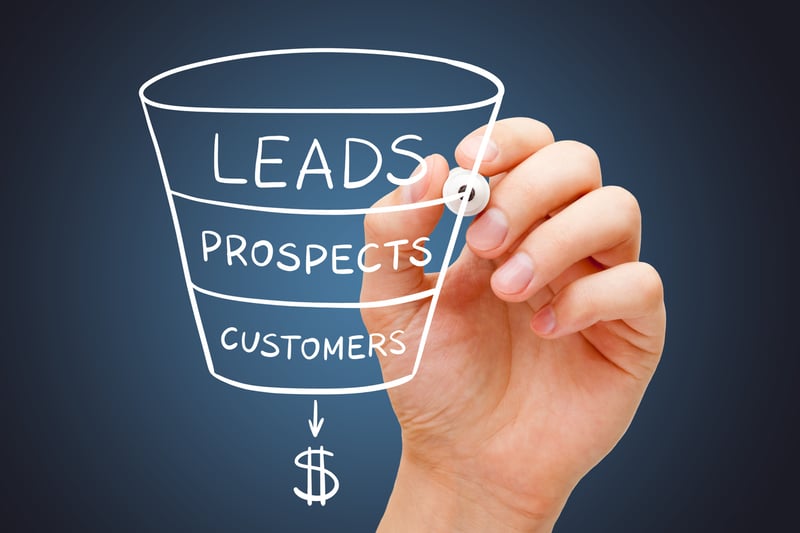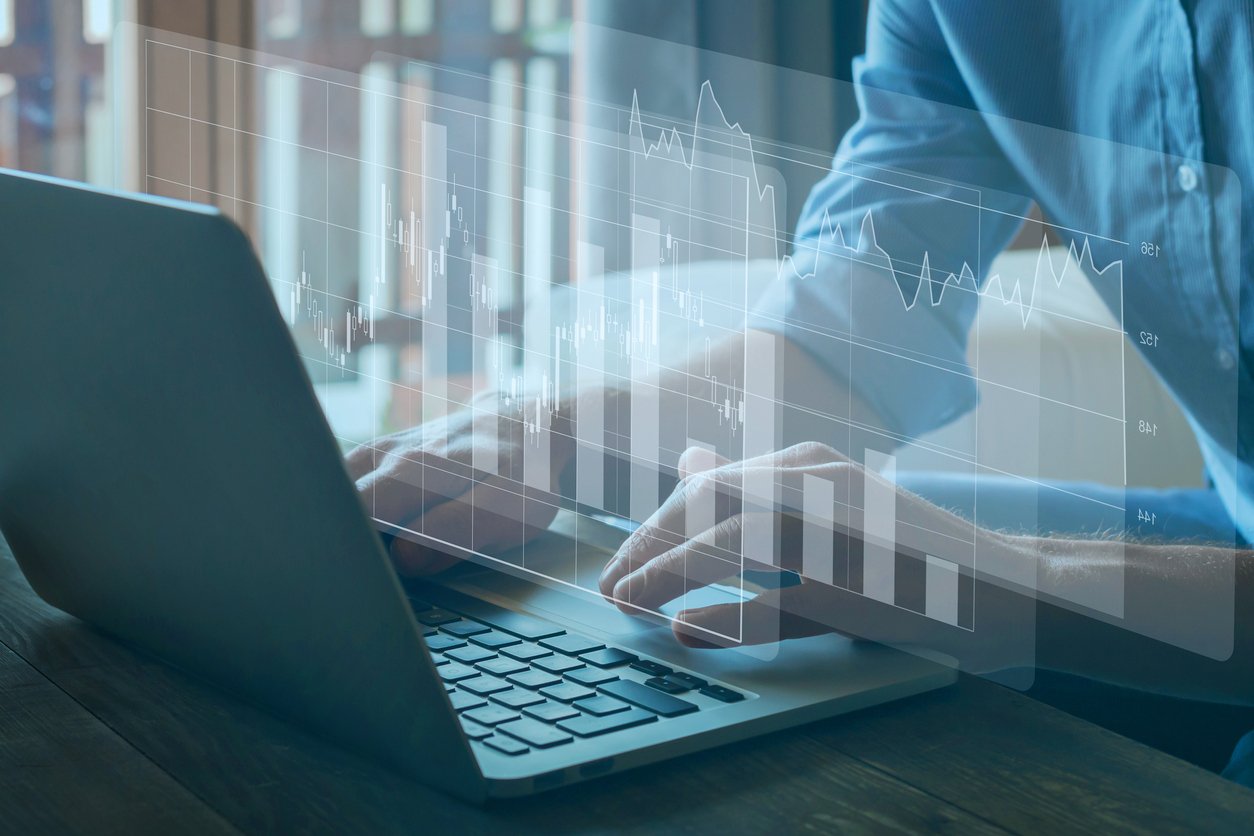
How to Build a B2B Sales Funnel [Stages and Examples]
 Updated on
Updated on
 By Carlos Correa
By Carlos Correa
Carlos Correa
Carlos has been involved in the sales space for well over ten years. He began in the insurance space as an individual sales agent, managing teams as s...
learn more
Carlos Correa
Carlos has been involved in the sales space for well over ten years. He began in the insurance space as an individual sales agent, managing teams as s...
Table of Contents
Table of Contents
What Is a B2B Sales Funnel?
A B2B sales funnel or pipeline refers to the various stages typical B2B prospects go through during the sales process. The chief goal of a B2B sales funnel is to transform leads into paying customers while increasing ROI is the secondary purpose.
B2B sales funnels are particular for given services or products, but the AIDA (Awareness-Interest-Desire-Action) buyer's journey model forms the basis of its structure.
While it may be enticing to think prospects move linearly through a B2B sales funnel, the reality is very different. Prospects move down and up the sales pipeline either non-linearly or linearly.
Significant B2B sales funnel traffic is required to conduct proper AB testing, meaning prospect and funnel optimization may take longer than expected. If you have the tools and prospect base to test, you should begin doing it immediately and regularly.
This article explores what a b2b sales funnel is, how to create it, the different models and stages, and the challenges involved with building one for your business.
B2B vs. B2C Funnel
While the basic shape of the sales funnel B2B model is similar to B2C (Business-to-Consumer), the mechanics and duration of the process are fundamentally different. Understanding these differences is key to creating effective B2B sales funnels.

|
Feature |
B2B Funnel |
B2C Funnel |
|
Decision Cycle |
Longer decision cycles (often months or even years). The sale is a complex, strategic investment. |
Shorter and faster (minutes to weeks). The purchase is often transactional and driven by immediate need or emotion. |
|
Stakeholders |
Multiple stakeholders (e.g., procurement, IT, department head, C-level executive) are involved in the buying committee. |
Typically a single decision-maker (the individual consumer). |
|
Sales Approach |
Relationship-driven sales are essential. Trust, long-term value, and detailed ROI justification are required. |
Often product/price-driven. Focus is on mass appeal and convenience. |
|
Purchase Value |
High monetary value and significant impact on the client's business operations. |
Lower monetary value and impact on the individual. |
This longer, more complex process is why developing a detailed B2B sales funnel template and studying B2B sales funnel examples are crucial for success in the business market.
How to Create a High-Performing B2B Sales Funnel
Creating an effective B2B sales funnel requires a structured, multi-step approach that aligns marketing efforts with sales execution, focusing on the unique needs of business buyers.
1. Map Out B2B Funnel Stages
The modern B2B funnel stages are more granular than the traditional three-stage model, reflecting the complexity of enterprise buying. Each stage requires specific actions and content to move the prospect closer to a sale.
- Awareness (Top of Funnel - ToFu): The prospect recognizes a business pain point or challenge. The goal is simple education. Touchpoints: Blog posts, industry reports, social media posts.
- Interest: The prospect starts researching potential solutions. They are looking for information, not a hard sell. Touchpoints: Whitepapers, eBooks, detailed guides.
- Consideration: The prospect evaluates different solution types (e.g., should they build a solution, or buy a platform?). Touchpoints: Webinars, comparison guides, expert interviews.
- Intent: The prospect shows clear readiness to buy by engaging with sales-focused content. Touchpoints: Pricing pages visits, vendor comparisons, contact forms.
- Evaluation: The prospect focuses on a small list of vendors, examining specific features and fit. Touchpoints: Product demos, free trials, consultation calls.
- Purchase (Bottom of Funnel - BoFu): The deal is finalized, contracts are signed, and the prospect becomes a customer. Touchpoints: Contract signing, service level agreements (SLAs), dedicated onboarding.
- Retention: Focusing on customer success and expanding the account value (upselling/cross-selling). This is crucial, as retaining a customer costs up to five times less than acquiring a new one. Touchpoints: Onboarding processes, customer success calls, loyalty programs.
2. Build Targeted Content for Each Stage
To successfully guide prospects through the B2B marketing funnel stages, the content must match the buyer's mindset. At the Awareness stage, blog posts and foundational guides build trust. In Consideration, prospects need data, so webinars and case studies are effective.
Finally, at Evaluation, nothing is better than a personalized product demo or a detailed proposal to close the deal. Using a comprehensive sales funnel for B2B means ensuring every piece of content has a strategic purpose.
3. Define Lead Qualification and Scoring
Effective lead management relies on defining key B2B sales funnel metrics.
- MQL (Marketing Qualified Lead): A lead judged ready to pass from marketing to sales based on engagement (e.g., downloaded a whitepaper).
- SQL (Sales Qualified Lead): A lead vetted by the sales team as having budget, authority, need, and timeline (BANT) and is actively working a deal.
- Conversion Rates: The percentage of leads that successfully move from one stage to the next.
Here are the key metrics to track for each stage:
|
B2B Funnel Stage |
Key Metric |
Definition |
|
Awareness → Interest |
Click-Through Rate (CTR) |
Percentage of viewers who click on a call-to-action (CTA). |
|
Interest → Consideration |
MQL Conversion Rate |
Percentage of leads who meet marketing qualification criteria. |
|
Evaluation → Purchase |
Win Rate |
Percentage of SQLs that convert into paying customers. |
4. Automate and Track the Funnel
Implementing a CRM system is non-negotiable for managing the volume and complexity of a B2B sales funnel. Tools like Ringy allow sales teams to automate and track the funnel through features such as:
- Drip Campaigns: Automated, personalized email sequences that nurture leads at scale.
- Lead Prioritization: Automatically scoring leads to ensure sales focuses on the highest-potential targets.
- Analytics: Providing real-time insight into lead movement.
Using a pre-built B2B sales funnel template within the CRM ensures consistency in the B2B sales process and data tracking across the entire sales organization.
5. Analyze and Optimize Performance
Closing the loop on the B2B sales funnel involves rigorous data analysis. Sales and marketing teams must regularly review dashboards to track:
- CTRs and Conversion Rates: To understand where engagement is high and where leads are dropping off.
- ROI (Return on Investment): To prove which marketing channels and sales activities are most profitable.
- Attribution: To credit specific touchpoints with generating revenue.
CRM dashboards allow teams to visualize B2B sales funnel metrics in real-time. If the conversion rate from SQL to closed deals is consistently below the industry average (which typically sits around 15-30%), the sales process needs immediate optimization.
B2B Sales Funnel Examples

What would a B2B sales funnel article be without some examples of the different types of models companies implement? Here we look at the basics behind each method so you'll have a better idea of how they work.
|
Model Name |
Core Focus and Primary Stages/Elements |
|
The AIDA Model |
Focus: Buyer's psychological journey. Stages: Attention $\rightarrow$ Interest $\rightarrow$ Desire $\rightarrow$ Action (Purchase). |
|
The Forrester Model |
Focus: Structuring outreach based on prospect engagement level. 5Is: Involvement, Interaction, Intimacy, Influence, Impact. |
|
McKinsey’s Loyalty Loop |
Focus: Driving customer retention and advocacy by mapping the post-purchase journey. Stages: Consider $\rightarrow$ Evaluate $\rightarrow$ Buy $\rightarrow$ Enjoy $\rightarrow$ Advocate $\rightarrow$ Bond. |
|
Heinz Marketing’s Bowtie |
Focus: Extends the funnel to include post-sale advocacy and loyalty; focused on metrics like Churn Rate, CLV, and Retention Rate. |
|
The Conversion Funnel |
Focus: Digital marketing strategy for generating sales by monitoring awareness to conversion (e.g., sign-up, form completion, purchase). Often based on AIDA. |
|
JB Media Group’s Sales Funnel |
Focus: Action-oriented, four-stage framework for content and sales efforts. Stages: Awareness $\rightarrow$ Consideration $\rightarrow$ Decision $\rightarrow$ Retention. |
|
RAIN Group's Buying Process |
Focus: Salespeople using questioning techniques to influence the buyer’s agenda and articulate value, building trust and relationships. |
The AIDA Model
The four-stage AIDA model utilizes these attributes to move the client through the B2B sales pipeline:
- Attention
- Interest
- Desire
- Action
During interactions with each phase, content generally attracts prospects' attention to your brand, builds interest in your service or product, stimulates a desire for it, and promotes actions to test or purchase it.
The Forrester Model
Forrester developed the 5Is marketing model to help businesses structure their outreach efforts.
The 5Is stand for the level of:
- Involvement
- Interaction
- Intimacy
- Influence
- Impact
These engagement actions are based on the prospects' interactions with a brand over a specific period. Metrics for the 5Is are measured via web analytics, customer interactions, qualitative client feedback, market sentiment, and more.
McKinsey's Loyalty Loop
Mckinsey's Loyalty Loop recognizes that once a client buys a product, they rethink whether purchasing the item was the correct thing to do if they would recommend it to friends or family, and wonder if they would repurchase the same item.
This method involves looking at the customer journey through six stages. The loyalty loop shows how prospects decide what they want to buy and whether they wish to stay with their choice. Here are the six phases to examine during the customer journey:
- Consider - The prospect considers options that fit their requirements
- Evaluate - The potential customer determines which is the best product or service for their needs
- Buy - Purchasing of a specific product or service
- Enjoy - During this phase, several situations can occur, but they're all based on the customer’s enjoyment
- Advocate - The customer turns into a brand advocate and recommends a company's products or services
- Bond - The client trusts the brand and has formed a strong bond with the organization.
Using these stages to track a client's journey in and out of business is an excellent way to gather invaluable insights into customer behavior. Mckingsley's Loyalty Loop is a system that promises to show a lot of positive results because it focuses on the customer first.
Heinz Marketing's Bowtie
The Heinz Marketing Bowtie stretches past conventional B2B sales funnels by including both customer advocacy and loyalty phases. Customers are captivated by the brand due to its concentration on building trust, strengthening its reputation, and maintaining long-term relations with its clients.
This strategy allows marketers to monitor revenue-impacting factors and track customer growth rates. Utilizing the Heinz Marketing Bowtie strategy, you can follow these metrics:
- Churn rate
- Retention rate
- Customer lifetime value
- Pipeline data for repeat customers and referrals
- Renewal rate
Besides the above insights, this strategy creates a competitive advantage because it's focused on keeping the clients satisfied and ardent after the sale.
The Conversion Funnel
The primary task of The Conversion Funnel is to generate sales. These strategies monitor the customer journey from awareness to conversion, which could mean signing up for a monthly email, completing a form, or purchasing a product.
Conversion funnels are the cornerstone of all e-Commerce business models, influencing prospects as soon as they notice a brand to the second they buy a product from it. Most e-Commerce conversion funnels utilize the AIDA model while using marketing triggers during stages to reach out to customers.
JB Media Group's Sales Funnel
The JB Media Group promotes a sales funnel built around four stages in the customer journey.
The table below showcases each phase with an example of what to do during each one:
|
JB Media Group Sales Funnel Stage |
Actionable Steps |
|
Awareness stage |
Offer prospects educational information to grow their awareness of a solution. |
|
Consideration stage |
Help the customer understand the product better by including buyer’s guides, videos, case studies, and more on your website |
|
Decision stage |
Once the customer is ready to purchase a product, you could offer them a free consultation, trial, or demo to bring them closer to sealing the deal |
|
Retention stage |
Continue to provide the customer with valuable information about the service or product sold. Increase customer lifetime value by nurturing clients after sales. |
RAIN Group's Buying Process
The RAIN Group's Buying Process utilizes questioning techniques to unravel in-depth information concerning the buyer's requirements and desires. Sales representatives sell perspectives, insights, and ideas that impact the purchaser's decision-making. With a complete understanding of the target market, salespeople can close more deals while overcoming hurdles in concluding a sale.
The following elements are included in the Rain Group's Buying Process:
- Understanding how to approach different buyer personas
- Influencing the buyer's agenda
- Building trust, rapport, and relationships with potential buyers
- Determining and articulating the value of your business's products or services
- Inspiring the prospect to take action
These areas are the most important to concentrate on when achieving success with this strategy.
Stages of a B2B Sales Funnel

B2B sales representatives need to be more systematic and strategic than business to consumer (B2C) organizations when approaching customers. Knowing the right moment to pitch a client or what to talk about next is vital to the outreach effort.
Understanding that the customer journey isn't a straight line can help you determine where they are in the B2B sales funnel. Follow these six stages of a B2B sales funnel to know where your prospects are.
1. Awareness
This phase involves creating awareness around your product or services through various inbound marketing channels, such as TikTok videos or blog posts. Sales and marketing teams promote the brand, share solutions or advice to common client issues, and collect leads.
2. Interest
During this stage, you need to concentrate on building the buyer-brand relationship through informative content. This could also involve retargeting prospects with a blog post or article explaining how your solution can help their problem.
3. Consideration
At this stage, prospects are considered qualified and think your solution can assist them. This is when sales and marketing efforts focus on the product or service. Case studies, free trials, and email marketing campaigns are excellent instruments to move the buyer along during this phase.
4. Intent
Intent shows the buyer's possible interest in your brand or product because it demonstrates buying signals, such as responding to an email or booking a demo. These buyers need to decide which solution to go with, so include product-focused videos or whitepapers in your marketing collateral that can support demonstration conversions or sales activity qualifications.
5. Evaluation
When the final buying decision occurs, the evaluation stage commences. Now that the people have researched and weighed up their options, it's time for them to choose a solution.
Sales teams should leverage urgency in their pitches to get the customer to sign off the deal faster. You can also discuss service level agreements, discounts, or other negotiable points here.
6. Purchase
Finally, the customer has purchased the product or service and has become your client. Now comes the most critical part, building a relationship so that retention rates improve and customer satisfaction levels increase.
Challenges When Building a Sales Funnel for B2B
Building and maintaining a successful sales funnel for B2B is complex due to the nature of business transactions. Several common challenges can disrupt the flow and efficiency of the B2B sales pipeline.
1. Long Sales Cycles and Multiple Decision-Makers
The extended timeline (often six to eighteen months) and the involvement of up to six to ten stakeholders in the buying process make maintaining momentum difficult.
- Solution: To prevent leads from going cold, sales teams must leverage automation and drip campaigns. These automated sequences deliver consistent, relevant, and personalized content over time. This keeps the brand top-of-mind and the lead "warm," ensuring they are ready to engage when their buying window opens.
2. Misalignment Between Sales and Marketing
Often referred to as the "silo effect," this misalignment occurs when Marketing generates leads that Sales deems unqualified, leading to wasted effort and friction.
- Solution: Shared CRM visibility is the key to resolving handoff issues. A unified system allows both teams to view the same B2B sales funnel metrics, lead scoring data, and activity history. This shared view ensures that Marketing knows exactly what an SQL looks like, and Sales trusts the quality of the leads being handed over. Companies with strong sales and marketing alignment achieve 20% higher revenue growth.
3. Data Fragmentation and Tracking Gaps
If data resides in disparate systems (e.g., separate spreadsheets, email platforms, and ad trackers), it's impossible to get a clear, end-to-end view of the B2B funnel.
- Solution: The importance of integrated analytics cannot be overstated. All systems must feed into one central source, typically the CRM, to consolidate data. This allows teams to accurately track conversion rates between B2B marketing funnel stages and perform revenue attribution, highlighting which channels deliver the most valuable customers.
4. Poor Lead Nurturing Practices
A significant challenge is treating all leads the same, resulting in generic communication that fails to resonate. This causes high lead decay and low conversion rates.
- Recommendation: Implement robust CRM automation and segmentation tactics. Instead of a one-size-fits-all approach, segment leads based on firmographics (company size, industry), behavior (website visits, content downloads), and stage in the B2B sales funnel. Automation then delivers hyper-relevant content to each segment, dramatically improving engagement and qualification rates.
B2B Sales Funnel Metrics You Should Track
Monitoring key performance indicators (KPIs) is essential for assessing the health and efficiency of any B2B sales funnel. These metrics provide the data necessary to identify bottlenecks, forecast revenue, and ensure the entire B2B sales pipeline is delivering a strong ROI.
|
Metric |
Definition |
Why It Matters |
|
MQL to SQL Conversion |
% of marketing leads becoming qualified sales leads |
Measures lead quality |
|
CAC (Customer Acquisition Cost) |
Cost per new client |
Determines ROI efficiency |
|
CLV (Customer Lifetime Value) |
Revenue from each customer over time |
Reveals long-term profitability |
|
Funnel Velocity |
Average time from lead to close |
Indicates sales efficiency |
These B2B sales funnel metrics move beyond simple vanity measures to provide a comprehensive view of business performance. By tracking the quality of leads (MQL to SQL), the speed of the process (Funnel Velocity), and the ultimate financial health (CAC and CLV), businesses can systematically optimize their entire B2B funnel for maximum profitability.
Conclusion

B2B sales funnels are integral to any online or e-Commerce business model. Whether managing the customer through their journey or monitoring behavior insights with your sales team, B2B sales funnels provide a wealth of information.
Combining your B2B sales funnel with a CRM platform is a great way to achieve results. A CRM solution like Ringy is perfect for storing and tracking customer data while keeping sales teams on top of outreach efforts.
Request a demo to see how Ringy has been helping organizations in the insurance, remote sales, finance, and recruiting sectors boost overall business productivity and sales.

Skyrocket your sales with the CRM that does it all.
Calling? Check. SMS? Check. Automation and AI? Check. Effortlessly keep in touch with your customers and boost your revenue without limits.

Take your sales to new heights with Ringy.
Sales in a slump? Ringy gives you the tools and flexibility you need to capture leads, engage with them, and turn them into customers.
Subscribe to Our Blog
Enter your email to get the latest updates sent straight to your inbox!
Categories
Related Articles




































































































